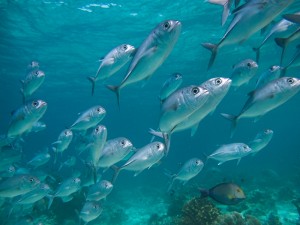Energy Efficiency
The ocean offers enough energy to power the world many times over, explore the facts now.
The ocean offers enough energy to power the world many times over, explore the facts now.
The planet’s oceans offer more than just an idyllic vacation spot, they offer enough potential energy to power all of our needs now and into the future. Considering the ocean covers more than 70 percent of the planet’s surface, yet humans have only explored 5 percent of the ocean, it is no wonder we often don’t fully understand how ocean power works. By exploring these ocean energy facts, we can better appreciate one of our more abundant, but underutilized, renewable energies have to offer.
 There are actually a few different ways to generate renewable energy from our oceans. Ocean power can be generated using tidal energy, wave power, ocean thermal energy conversion (OTEC), ocean currents, ocean wind energy and salinity gradients. For the sake of this discussion we will associate the ocean wind power to renewable wind energy and tidal energy was previously covered. That leaves us to focus on the remaining ocean power production methods noted above. Let’s take a moment to review each of those methods.
There are actually a few different ways to generate renewable energy from our oceans. Ocean power can be generated using tidal energy, wave power, ocean thermal energy conversion (OTEC), ocean currents, ocean wind energy and salinity gradients. For the sake of this discussion we will associate the ocean wind power to renewable wind energy and tidal energy was previously covered. That leaves us to focus on the remaining ocean power production methods noted above. Let’s take a moment to review each of those methods.
Wave power is the method where energy produced by waves at sea is harnessed and reused for other means such as electricity production. While the potential for wave power is quite high, it has proven to be a difficult method to master on a large scale. In fact, based on current research, there are only a handful of experimental wave generator plants in operation around the world.
One such implementation off the coast of Oregon is actually the nation’s first commercial wave power farm. The wave power farm utilizes the wave energy that is produced when a float on a buoy flows with the natural movement of the ocean waves. This in turn causes an attached plunger to follow the same kind of movement. This is attached to a hydraulic pump that converts the vertical movement to a circular motion, driving an electric generator to produce electricity which is then sent to shore through underwater cables.
OTEC actually utilizes the temperature differences found between different depths to produce energy. Energy generation occurs by utilizing the ocean’s warm surface water to vaporize a fluid with a low boiling point, such as Ammonia. This vapor expands, spinning a turbine attached to a more traditional electric generator. The vapor is then cooled using the cool deeper waters from the ocean, turning the vapor back into the original working liquid form, maintaining a close loop – or reusable process. The cycle will be repeated over and over, spinning the turbine to continuously produce energy. The efficiency of this cycle is determined by the difference in temperature associated to the surface and lower depths of the ocean.
Estimates from a publication by the U.S. Department of the Interior found that if we were able to capture just 1/1000th of the potential energy from the Gulf Stream, we could produce 35 percent of Florida’s energy needs. Similar to other ocean energy production methods, the ocean currents are not widely producing energy, though it will play an important role in the future.
The kinetic energy produced by the oceans currents can be harnessed using various types of open flow rotors, similar to how wind power is produced from a wind turbine.
Generating energy using salinity gradients has been confirmed in the laboratory, though has not proven practical on the open market as of yet. The method produces energy utilizing the osmotic pressure difference between fresh water and saltwater.
There are different salinity gradient power generation methods, however one of the most commonly discussed is pressure-retarded osmosis (PRO). Within the PRO method, seawater is pumped into a pressure chamber where the pressure is lower than the difference between fresh and salt water pressure. Fresh water then moves in a semi permeable membrane and increases its volume in the chamber. As the pressure in the chamber is compensated, a turbine spins to generate electricity.
The energy needs across the globe will only continue to increase. Burning fossil fuels simply won’t cut it as a long term strategy, hence the need to explore all available options. The ocean has enough potential energy to solve much of our energy needs, especially in coastal regions. Thus, support of continued research and demand for alternative energy will help expedite the adoption of these proven methods of sustainable energy.